Mastitis
Local names: Luo: Tuo thuno / Embu: yele / Borana & Gabbra:hiha goru, butha / Kamba: Uwau wa nondo, mukamo / Kipsigis: miatapkinai / Maragoli:lifuuti / Somali: candho-barar, canda-barar, carar, galleh, goof / Turkana: loebeta / Kikuyu: Murimu wa nyondo, kuruara mukamo / Maasai: Enkeeya Ollki / Kiswahili: matiti
Common names: mammitis, mammite (French), inflammation de la ubres (Spanish)
Description: Management disease
Mastitis, or inflammation of the udder, is a result of the udders’ response to bacteria invading the milk gland and rapidly multiplying inside it.
- Clinical (visible) mastitis: The udder swells up, the skin looks reddish and feels hot and the swollen quarter/teat is painful. The milk looks abnormal (watery consistence, discoloured, small lumps in the milk); the milk flow is reduced or stops. In some mastitis cases there can be difficulties in extracting the milk because teat canals are blocked and secretion of milk by the gland is reduced. Clinical mastitis can be mild, severe or very severe.
- Acute mastitis is very severe mastitis. The cow has high fever, stops feeding and can even die. It is caused by bacteria that normally live in the guts of the cow.
- Subclinical mastitis: In the majority of cases the beginning of the mastitis after bacteria have entered the milk gland is more gradual. Signs can be so mild as to go almost unnoticed. There may be a very mild transient swelling that disappears quickly; slight changes in the milk can be seen but don’t last; milk flow is not affected; the cow shows no pain and feeds normally. This very common almost invisible form of mastitis is called subclinical mastitis.
Following subclinical mild mastitis the quarter may return to normal, eliminate all mastitis bacteria from inside the gland and make a full recovery. But in a number of cases quarters that look normal remain infected with bacteria for weeks and months. With some mastitis bacteria the affected quarters can remain infected forever! This is called chronic mastitis. Over one to three successive lactations quarters with chronic mastitis undergo changes from the normal “spongy” consistence of healthy gland tissue to the hard consistence of dead tissue. The final outcome of a chronic mastitis is a ‘dead quarter’ that no longer produces any milk. It is estimated that chronic mastitis leads to between 20% and 40% loss of milk available for consumption and for sale. Older cows whose udders are more likely to be affected by chronic mastitis are a common source of mastitis for young cows with healthy clean udders.
- Pigs sometimes get mastitis immediately after giving birth when the piglets are very young.
- Trauma and injury during milking or during fighting between cattle can damage the teat !!!
- Mycoplasma are special bacteria, which may spread from cow to cow through the air. They infect the body of the animal and then invade the udder via the blood. This is a very specific infection which infects all cattle, causes mastitis, respiratory disease, abortions and makes the whole herd unproductive.
- Sheep and goats can also get a very severe form of mastitis called Contagious Agalactia, caused by another type of mycoplasma, which has similar devastating effect on the goat herd (mastitis, arthritis, abortion, septicemia) as the mycoplasma in cattle.
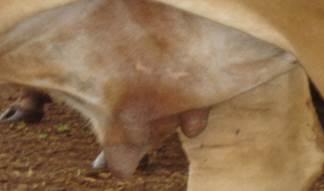 (c) W. Ayako, KARI Naivasha |
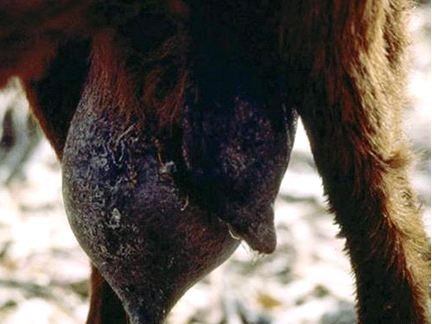
|
Detecting Mastitis
The California Mastitis Test (CMT)
When an udder is infected by mastitis bacteria and is inflamed it produces inflammation cells. A high number of these cells is a clear sign of mastitis. The high number of cells can be detected by examining a milk sample from each quarter. The most common mastitis detection test, used at milking is the ‘California Mastitis Test’ (CMT), sometimes also called ‘Schalm Test’. The California Mastitis Test fluid is mixed 1:1 with the milk (slightly more test fluid than milk does not affect the test outcome). The test fluid contains a purple dye and picks up slight invisible changes in the milk that are caused by the mastitis. If the quarter is affected by mastitis the mix of test fluid and milk becomes thick and can also change in colour. If the quarter is free of mastitis the test fluid-milk-mix does not change colour and retains the normal milk fluid consistence (see illustrations below).
How to perform the California Mastitis Test (CMT):
- Milk one streak of milk into each cup of the test paddle
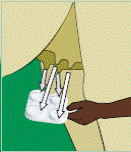
- The four cups of the test paddle should be maximum half full
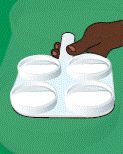
- Add an equal amount of test fluid to each cup (milk and test fluid = one to one)
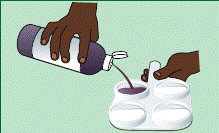
- Mix test fluid and milk by rotating the CMT paddle gently
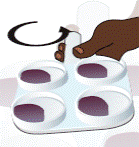
- Where the fluid becomes thick and changes in color the quarter has mastitis
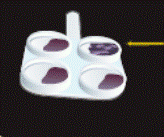
- Always remember from which quarter you took the mastitis milk

CMT Results – what do they mean
After mixing milk and test fluid and rotating the paddle...
- The mixture remains watery and does not thicken -> Negative Reaction – this is the best result, it means there is no infection with mastitis bacteria in the tested quarter.
- There is slight thickening of the mixture, which disappears when paddle is rotated -> Trace Reaction – possible infection (if all 4 quarters* show a trace reaction there is no infection, but if only one quarter shows trace reaction presence of infection in this quarter is possible)
- Mixture clearly thickens but remains liquid (no gel formation) after long rotation of the test paddle (more than 20 seconds) thickening may disappear -> Weak Positive Reaction (1+) – mastitis infection
- Mixture thickens immediately and forms a slight permanent gel, which sits at the center of the test cup when paddle is rotated -> Clear Positive Reaction (2+) - mastitis infection
- Gel is formed and surface of the mixture remains raised like a fried egg when rotating the paddle -> Strong Positive (3+) – severe mastitis infection
* In old cattle and in very late lactation all 4 quarters can show a Trace Reaction without being infected by mastitis bacteria.
The Different Types of Mastitis
Many different bacteria can infect the udder and cause damage to the milk gland. A few mastitis bacteria are specialized and live mostly inside the udder. But the majority of mastitis bacteria are found everywhere in the outside environment, including in pus, in faeces and in dirty water and bedding. So the bacteria that can cause mastitis come basically from two sources:
- The environment - this includes floor, bedding, housing, pasture, dirty water, but also faeces and purulent wounds on the cows’ skin and feet. Coli mastitis comes from the environment.
- Infected quarters - Bacteria are transferred from ‘mastitis cows’ to ‘clean cows’ via the milkers hands, the udder cloth, contaminated teat dip, contaminated milking equipment and also through flies; cows that have one or more quarters affected by chronic mastitis are the most important source of infection for other cows with healthy clean udders. The mastitis infected quarter is a reservoir of bacteria from where other cattle in the herd become infected over and over again. Examples are Streptococcus & Staphylococcus mastitis.
Only the analysis of a milk sample at a fully equipped bacteriological laboratory can confirm:
- If any mastitis bacteria have infected the sampled quarter
- Which type of mastitis bacteria are present
- Which drugs are the best choice for possible treatment of the mastitis
One can differentiate between three major types of mastitis, which are named after the bacteria commonly involved.
1. Streptococcus Mastitis
Streptococci are transmitted from infected to clean quarters, mostly during milking. Between the infection and the first signs of mastitis several days can pass. In most cases this mastitis does not produce strong visible signs. It is subclinical and can often only be detected through minor changes in the milk and by using the CMT. Once established Streptococcus mastitis tends to persist and become chronic. It leads to hardening of the gland, progressive loss of milk producing tissue and ultimately dead quarters. This process can take two to three lactations.
2. Staphylococcus Mastitis
The Staphylococcus mastitis is mostly transmitted from infected quarters to clean quarters, but the source of infection can also be infected skin wounds, any lesions that produce pus and even a person that is suffering from a severe cold and is sneezing and coughing while milking. Like Streptococcus mastitis, Staphylococcus also persists and becomes chronic, leading to destruction of the milk gland tissue. In most cases a fresh Staphylococcus mastitis is only recognised from minor changes in the milk and through the CMT.
3. Coli Mastitis
Coli live inside the intestine of the cow and thrive in dung and in dirty wet environments. The quarter is infected at or very soon after milking, before the teat canal has closed. Coli bacteria invade the milk gland through the teat coming directly from the dirty teat skin or from the dirty environment. High yielding and freshly calved cattle are at a very high risk from this type of mastitis. Within a very short time after infection of the quarter with Coli bacteria the cow develops high fever and stops eating, the udder swells up and is very hot and painful. Either there is no more milk coming from the affected quarter or the milk looks completely abnormal (brownish-yellow, very thin and watery). The fever can be very high (41 ̊Celsius), the cow may no longer stand up and is at risk of dying if not treated early. – Outcome of Coli mastitis can vary from spontaneous self-cure to death of the cow.
4. There are other by far less common forms of mastitis.
One very dangerous type of mastitis is caused by Fungi, which are present in wet environments. Fungi cannot invade the teat canal but are introduced into the canal by humans who:
- Treat cows with Mastitis Tubes (see treatment) without disinfecting the teat
- Use Mastitis Tubes for more than one treatment (if an opened mastitis tubes is not emptied at once the fungi will live and multiply in the Penicillin that is inside the mastitis treatment tubes!)
- Try to widen a narrow teat canal or unblock a teat by force using unclean instruments (blocked teat canals should only be opened by a veterinarian)
Mastitis due to Fungi is incurable. Fungi multiply in Penicllin – so using mastitis tubes even makes things worse!
Treating Mastitis
Before we had antibiotics for treatment of infections, mastitis was treated by:
- Isolating the cow and giving it good hay, feed and access to clean water
- Talk to the cow and make it feel cared for. It does make a difference.
- Frequently washing the udder with clean cold soapy water to cool it down and most importantly
- Very frequent (every 1hour) milking out of the affected quarters until the udder feels normal again. This can take one to three days and nights depending on severity of infection, so is a very labour intensive solution. If no medicine is available this solution can still be employed with success, but remember the every hour milking is also needed during the night, so a shift of duties of caretakers may be necessary.
This treatment is still the only one giving a possibility of cure for fungal mastitis.
Modern Treatment
If the mastitis is not acute (with fever) it is normally better to first have a milk sample examined by a laboratory. This will provide clear information on the chances for curing the infection and on the best choice of drugs to be used. It is often cheaper to pay the lab than treating randomly with whatever drug is available. One easily ends up trying out several mastitis drugs that cost a lot of money – but in the end all of them may not work and the quarter may suffer irreparable damage from successive treatment failures (or even become infected with fungi!).
The standard treatment for a mastitis infected quarter is by inserting the tip of a mastitis tube into the teat canal and instilling an antibiotic cream through the teat canal into the udder. Mastitis tubes are expensive. Some bacteria are resistant against the antibiotics in the mastitis tube. Before buying the tube for treatment it is good to have information from laboratory analysis of a milk sample as to which antibiotic (which brand of mastitis tube) will be efficient for a specific mastitis case.
If used in the wrong way mastitis tubes can easily do more harm than good. When applying an antibiotic by way of the teat canal the utmost care has to be taken NOT TO INTRODUCE MORE BACTERIA or even Fungi into the gland! Otherwise the treatment may start off an additional mastitis which may be worse than the one that is being treated.
When using mastitis tubes for mastitis treatment the following steps must be followed:
- Clean the teat
- Completely milk out the quarter to be treated
- Clean the teat again such that it is perfectly clean and dry
- Disinfect the teat, especially the tip (use cotton soaked in 70% alcohol as disinfectant)
- Open the mastitis tube by taking of the cap - the tip of the mastitis tube must not touch anything before being inserted into the teat canal! (the person applying the mastitis tube must wash and disinfect their hands before doing this)
- Insert the mastitis tube tip into the teat canal, but don’t insert it fully
- Press the antibiotic cream that is inside the mastitis tube into the teat with continuous gentle pressure
- Pull out the tip of the tube, firmly hold the tip of the teat between thumb and finger and with the other hand massage the teat upward moving the antibiotic cream through the teat into the quarter
- Repeat this treatment every 12 hours (or at every milking time) such that the antibiotic is applied for at least three successive milking times
- Starting from the last treatment, observe the milk withdrawal period provided on the package of the mastitis tube
- The success of the treatment can be checked by sending a milk sample to the laboratory two to three weeks after the last treatment
Bacteria surviving inside the teat canal in between milking times are a potential reservoir for new mastitis infections. Pushing these bacteria up into the udder with the tip of the mastitis tube can easily start a new mastitis.
Special aspects when treating Streptococcus Mastitis:
If treated early and with the correct choice of drug this form of mastitis normally responds well to treatment. Resistance of Streptococcus to vet drugs is less common than with Staphylococcus. Most Streptococci respond well to Penicillin.
Special aspects when treating Staphylococcus mastitis:
Staphylococcus mastitis is very difficult to treat. Even with correct choice of drug only one out of four mastitis cases are cured. In old cows the cure rate can even be lower. Treating this form of mastitis during lactation almost never succeeds. The best time for treatment is at drying off (see Dry-cow-therapy). Resistance of Staphylococcus to vet drugs is very common and many drugs don’t work. - If the cow is old it is better not to attempt any Staphylococcus mastitis treatment.
Dry-cow-therapy is the use of specific dry-cow-mastitis-tubes after the last and final milking (4 tubes are used - one for each quarter). At drying off is the most effective time to treat mastitis. Dry cow therapy has the following advantages over treatments carried out during the lactation period:
- The cure rate is higher especially for Staphylococcus
- A much higher dose of antibiotic can be applied
- The antibiotic is active inside the udder for much longer
- The antibiotic also protects the dry udder against new mastitis infections
- Only one single treatment time is needed
When applying the dry-cow-mastitis-tubes follow the same steps as for normal mastitis tubes.
Special aspects when treating Coli mastitis
Treatment must begin as early as possible after the first signs appear! Coli mastitis treatment requires emptying as much milk as feasible from the affected quarter, even if this is difficult. Reducing the swelling by cooling the udder and stripping out a bit of milk again and again can save the cows life. In addition the cow requires injections of an anti-inflammatory drug and an antibiotic. If the cow is in a critical condition she also requires intravenous fluids.
